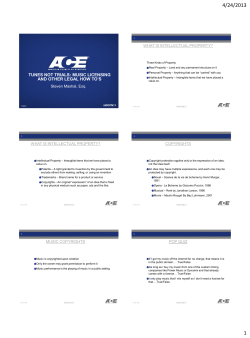
Commonwealth of Puerto Rico Tax Reform Project PR Association of Finance Professionals
Commonwealth of Puerto Rico Tax Reform Project PR Association of Finance Professionals October 24, 2014 Data included are for discussion purposes only; subject to further revision Agenda • • • • • Project Objectives Description of Macroeconomic Model and Simulation Methodology High Level Observations High Level View of the Components of Alternative Tax Structure Detailed Options for Alternative Tax Structure Consumption Tax Individual Income Tax Domestic Business Tax Inbound Tax (Law 154) Transition Issues • Tax Administration • Next Steps Project Objectives •Essential Elements of New Tax Structure Produce adequate revenue Distribute the burden of taxation fairly Promote economic growth Increase international competitiveness of products, workers and businesses Minimize interference with private decision making Streamline compliance and administration • Develop a Puerto Rico Centric Macroeconomic Model for Tax and Economic Policy • Improve Revenue Operations Macroeconomic Model Macroeconomic Model and Simulation Methodology • General explanation of the macroeconomic model • What is it? • What does it do? • What does it contain? • What does it produce? 4 Macroeconomic Modeling Suite • • A Computable General Equilibrium (CGE) model of Puerto Rico’s economy • Accounts for around 90 production sectors, production technology, input demands, output decisions, consumers (households), investors, government, foreign demand for domestic output (exports) and domestic demand for foreign output (imports), and many other variables • For the current purpose: Captures the current tax system and allows for new taxes to be applied, revenue targets to be hit, etc. • A large array (>3 million) of interconnected economic behavioral and accounting equations, and a database containing many millions of data points • A state-of-the-art simulation tool, constructed over a period of 7 months by a team of PhD economists experienced in policy analysis with advanced empirical techniques, • Highly valuable input and assistance from local economists and policy experts • Provides highly flexible analytical capacity for a range of economic policy analysis and forecasting uses, and produces a rich variety of output to be analyzed and interpreted A Structural Macroeconomic Forecasting model • A combination of estimation-based and structural equations used for creating macroeconomic projections for Puerto Rico • Also assists in informing the macroeconomic baseline for the CGE model • Used in concert with the insight and knowledge of experienced economists, the modeling suite provides a highly flexible simulation and forecasting capacity • The models will be applied to economic analysis and forecasting on an ongoing basis by economists in Puerto Rico, to be trained and supported by the developers as necessary 5 High Level Structural, Revenue and Economic Observations High Level Observations • General Observation Current income and consumption tax structures are inordinately complex due principally to a plethora of special provisions (that have not been subjected to a cost-benefit analysis) • Revenue Observations Revenue from consumption and individual income taxes are below peers (Slide 9 and 10) Less than ten percent of filers are responsible for almost 78 percent of income tax receipts (Slide 11) Existing tax preferences reduce the tax base and require higher rates to achieve revenue targets • Economic Observations Current consumption taxes are highly regressive (Slides 12 and 13) Capital income bears a smaller burden than labor income (Slide 14) Tax preferences create economic inefficiency 7 Taxes as a Percentage of GDP in Puerto Rico Compared to Selected Jurisdictions Taxes as a Percent of GDP: Puerto Rico and OECD Countries, 2011 Puerto Rico United States United Kingdom Turkey Switzerland Sweden Spain Slovenia Slovak Republic Portugal Poland Norway New Zealand Netherlands Mexico Luxembourg Korea Japan Italy Israel Ireland Iceland Hungary Greece Germany France Finland Estonia Denmark Czech Republic Chile Canada Belgium Austria Australia Personal Income Corporate Income SS Contributions Payroll / Workforce Property Goods/Services 0 5 10 15 20 25 30 35 40 45 50 8 Comparison of Puerto Rico to OECD Countries (Percentage of GDP) Puerto Rico Average Range Personal Income 2.18% 8.32% 2.18-24.18% Corporate Income 2.67% 2.97% 1.21-10.70% SS Contributions 2.65% 8.96% 0.00-16.70% Payroll/Workforce 0.61% 0.41% 0.00-4.44% Property 0.75% 1.76% 0.29-4.16% Goods/Services 2.06% 10.77% 2.06-15.91% Total 10.91% 33.17% 9 2013 Income Tax Liability by Income Class (In Millions of USD)3 Income Level Less than $20,000 Between $19,999 and $40,000 Between $39,999 and $60,000 Greater than $59,999 Total Share of Tax Tax Liability Share of Tax Tax Liability (Including (Excluding SS (Excluding SS & Social Security and & Medicare) Medicare) Medicare) 538,026 $4 .21% $368 9.58% 319,108 $191 9.17% $791 20.59% 107,107 $270 12.98% $604 15.72% 89,459 $1,614 77.64%(*) $2,079 54.11% 1,053,700 $2,079 100.00% $3,842 100.00% Filers (Including Social Security and Medicare) (3) Distributional analysis based on 2012 individual tax returns provided by Department of Treasury (*)Less than 10% of filers pay nearly 78% of the individual income tax 10 2013 Sales Tax Liability By Income Class4 Sales tax liability, as a percentage of income, falls with increases in income. This is a standard feature of a sales tax and its regressive nature indicating the sales tax burden is highest on lower incomes. Total Sales Tax Liability (In Millions) Liability Per HH Liability As Fraction of HH Income 0 to $21,790 $381 $560 5.51% $21,800 to $33,000 $194 $833 3.07% $33,050 to $69,500 $345 $1,042 2.22% $69,600 to $84,170 $66 $1,464 1.93% Greater than $84,170 $187 $2,209 1.55% Income bracket (4) Figures based on expenditure shares on goods and services provided by the Department of Labor and Human Resources and allocated to income groups Footnote: Based on relative expenditure amounts Consumer Expenditure Survey 11 2013 Vehicle, Gasoline, Alcohol, & Tobacco Excise Tax By Income Class Similar to sales tax liability, excise tax liability, as a percentage of income, falls with increases in income. This is a standard feature of an excise tax and its regressive nature, indicating the burden is highest on lower incomes. Number of Households Average Income Excise Tax Liability Per Household Less Than $21,800 681,339 $10,163 $503.37 31.28%/49.50% 4.95% $21,800 to $33,000 233,080 $27,107 $749.50 15.93%/16.93% 2.76% $33,050 to $69,500 331,584 $47,011 $1,024.60 30.99%/24.09% 2.18% $69,600 to $84,170 45,579 $75,990 $1,416.75 5.89%/3.31% 1.86% Greater than $84,170 84,590 $142,953 $2,052.02 15.90%/6.17% 1.44% Income Range Share of Total Liability/Pct of Households Liability as Percent of Income 12 2012 Total and Capital Income Reported by Income Level (In Millions of USD) Highest income levels receive nearly all of the favorable treatment of capital income Total Income Capital Income Subject to Preferential Rates Pct of Income Taxed At Preferential Rates Less than $20,000 $5,499 $1.3 0.02% Between $19,999 and $40,000 $9,111 $3.9 0.04% Between $39,999 and $60,000 $5,151 $10.6 0.21% Greater than $59,999 $10,394 $490.5 4.72% Income Level 13 2013 Income and Consumption Tax By Income Level2 Income Tax Consumption Taxes Total Share of all taxes Weighted Distribution (Weighted by Number of HHs) 0 to $21,790 $10 $724 $734 16.94% 3.24% $21,800 to $33,000 $72 $368 $440 10.16% 5.68% $33,050 to $69,500 $434 $685 $1,116 25.75% 10.12% $69,600 to $84,170 $151 $131 $281 6.50% 18.59% Greater than $84,170 $1,410 $361 $1,763 40.65% 62.37% Total $2,079 $2,271 $4,337 Income bracket (2) Income tax distribution based on 2012 individual income tax returns provided by Department of Treasury Sales and Use Tax portion of consumption tax liability based on expenditure shares on goods and services provided by the Department of Labor and Human Resources and allocated to income groups based on relative expenditure amounts Consumer Expenditure Survey 14 Observations Observations As part of the Reform Project, more than 40 meetings have taken place with various interest groups, among them Asociacion de Industriales, Camara de Comercio, Asociacion de Bancos, Centro Unido de Detallistas, and others. In regards to Act 154, meetings and discussions have taken place with pharmaceutical, biotech companies and other companies subject to Act 154. KPMG has modeled several options using the Macroeconomic model developed, considering different tax systems and using the experience in other countries. Right now, certain fine tuning of the proposal is taking place. Results are being presented to the Advisory Committee appointed by the Governor, to the Governor and members of the Legislature. Decisions in regards to the new tax structure will be discussed with interest groups. Drafting of legislation commenced, will run in various parallel groups in charge of the drafting of legislation related to consumption tax, individual income tax, corporate tax (domestic and inbound taxes) and property taxes. Transition issues are being considered and included. Tax administration and reorganization of Treasury to achieve the goals of the new system, also part of the study. 14
© Copyright 2025





















